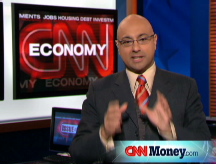Jump in food prices biggest in 18 years
But overall consumer prices up less than expected, and annual increase stands at 3.9%.
NEW YORK (CNNMoney.com) -- Consumers had to shell out more for goods, services and especially food in April, according to a government report released Wednesday, but the rise was lower than expected.
The Consumer Price Index, a key inflation reading, rose 0.2% last month, according to the Labor Department. That was lower than the 0.3% jump recorded in March and fell short of 0.3% rise a consensus of economists surveyed by Briefing.com had forecast.
The rise in prices in April left overall prices 3.9% above where they were 12 months earlier, below the 4% rise on that basis in March.
Bloated food costs contributed the most to the index's rise. Seasonally adjusted food prices rose 0.9% on a month-over-month basis in April, making it the biggest jump in 18 years, according to the Labor Department. Last month's food costs were 5.1% higher than in April 2007.
Fruit and vegetable prices rose 2% in April, and bread prices increased 1.5% in the month. The cost of bread was 14.1% higher than the year-ago period.
The index for dairy products jumped 1.2%, and milk prices rose 0.9% last month. April's milk prices were 13.5% higher than in April 2007.
But prices for dining out grew only 0.3% in the month, as consumers held back on discretionary purchases and focused on necessities such as food from grocery stores.
"More folks are walking to work and bringing a brown-bag lunch," said Wachovia economist Mark Vitner in a report. "Higher food and energy prices are taking money out of consumers' pockets and causing folks to cut back on spending on just about everything else."
Surprisingly, the Labor Department reported that seasonally adjusted energy prices did not rise from March's levels. Though unadjusted gasoline prices were up 5.6% in April from a month earlier, seasonal adjustments made to that estimate resulted in gasoline prices being down 2% on that basis.
That's despite the fact that gasoline prices posted a string of 16 straight daily record highs in April, according to the motorist group AAA. Other measures of national average gasoline prices, including the U.S. Department of Energy and AAA, showed gasoline prices and rose an average of 9% to 10% over the course of the month. Crude oil prices rose 11% in April.
"April and May is typically a period of rising gasoline prices, so that's definitely the number that sticks out," said Wachovia economist Sam Bullard, who expects the number to rise in May. "It seems to be a seasonal-adjustment issue."
The closely watched core CPI, which strips out volatile food and energy prices, rose 0.1%. Economists had expected a 0.2% rise after a 0.2% jump in January.
Core CPI posted a 12-month change of 2.3%, down from a 2.4% rise on that basis in March.
The annualized inflation reading is still a bit above the perceived comfort zone of central bankers. The Federal Reserve is generally believed to want to see the 12-month change in core inflation readings remain between 1% and 2%.
The Fed launched a series of cuts to its key interest rate in September in an effort to boost the economy and stave off a recession. But the rate cuts tend to be inflationary, driving consumer prices higher.
The fed funds rate now stands at 2%. But in announcing the last rate cut in April, the central bank hinted that it would halt its rate-cutting campaign in an effort to stem the tide of inflation.
In a speech to a business group in Vancouver, British Columbia, on Tuesday, San Francisco Fed President Janet Yellen said inflation "departed from desirable levels" this year, but she expects it to moderate over the next two years.
In the meantime, rising food and fuel prices remain a concern for consumers - as the economy absorbs the stimulus payments aimed at spurring it that began in late April.
"The run-up in prices for basic necessities is one reason credit card balances are increasing so rapidly, and raises questions as to how much punch the tax rebates will provide to the overall economy," said Vitner. ![]()


